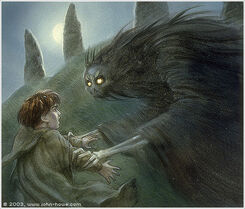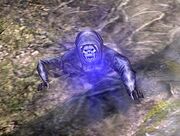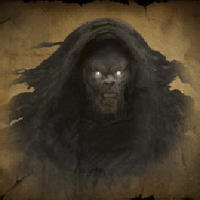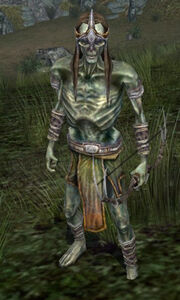
|
"Can you see anything?" "Nothing. There's nothing." The descriptive majority of this article's text is unsourced, and should be supported with references. |

Frodo Baggins attacked by a Barrow-wight
- "Cold be hand and heart and bone
and cold be sleep under stone
never more to wake on stony bed
never, till the Sun fails and the Moon is dead
In the black wind the stars shall die
and still be gold here let them lie
till the Dark Lord lifts his hand
over dead sea and withered land." - —The dismal, tortured chant of the Barrow-wight
The Barrow-wights were shape-shifting beings of darkness, similar in disposition to Wraiths, who dwelt in dark places of Eriador such as the Barrow-downs.
Description[]
Wights appeared as dark phantoms whose eyes were luminous and cold, and whose voice was horrible yet hypnotic; their skeletal hands had a touch like ice and a deadly grip. Victims under a Wight's spell would lose their will; in this way the Barrow-wights drew the living into the tombs of the downs. Some, if not all, victims were laid on a stone altar and bound in chains of gold, to then be draped in pale cloth and jewelry of ancient dead, and killed by a wight with a sacrificial sword.

A Barrow-wight in The Battle for Middle-earth II
East of the Brandywine River beyond the Old Forest were the Barrow-downs, the most ancient burial ground of Men in Middle-earth. There were no trees nor water there, but only grass and turf covering dome-shaped hills crowned with monoliths and great rings of white stone. These hills were the burial mounds that were made in the First Age of the Sun for the Edain, and later in Second and Third Ages for the Kings of Men.

Barrow-wights as portrayed in the LOTR Trading Card Game
In the darkness, wights were powerful spirits, resisted only by strong incantations such as Tom Bombadil's song. Dependent for many centuries on the dark security of burial vaults, they feared the sunlight, and would be diminished in exposure to it.
History[]
The Barrow-wights began appearing in the Barrow-downs after the Dúnedain of Cardolan succumbed to the ravages of the Great Plague. In roughly TA 1409, evil spirits were sent by the Witch-king of Angmar, who wished to keep the Dúnedain from resettling the region.
On September 28 of 3018, Frodo Baggins and his companions, Sam Gamgee, Merry, and Pippin, while passing through the Barrow-downs, were captured by wights and trapped in what was believed to be the cairn of the last prince of Cardolan.[1]

A Barrow-wight
There they were almost slain by a wight; three of the Hobbits had been lain in a barrow filled with a strange green light and were dressed in white robes and wore jewels and gold and had a sword across their necks. The wight had finished an incantation, and was preparing to finish them off when Frodo summoned up the courage to slice off its hand; he then called upon Tom Bombadil when the wight extinguished the dim light in the cavern. Bombadil performed a song in the barrow and, through the rare power of his singing, caused the wight to flee with a shriek; he then gave the hobbits swords and spread out the gold and treasures from the barrow on the grass, so that the barrow's spell was broken and no wight could make habitat there.[2][3]
Behind the scenes[]
It is possible that the Witch-king himself had visited the Barrow-downs during the Ringwraiths' search for Frodo, and that it was he who had roused the Barrow-wights to be vigilant for trespassers on their land.
Other versions of the legendarium[]
Due to his inspiration from the Hrómundar saga Gripssonar, during the writing of The Lord of the Rings Tolkien at first saw a link between the Wights and the Ringwraiths, initially describing the Black Riders as "horsed Wights", but the suggestion that they were the same kind of creatures was dropped in the published work.
Inspirations[]
The concept of a burial mound housing evil spirits was not a new one created by Tolkien. The Barrow-wights themselves resemble a creature in Germanic Mythology known in Norse as Draugar (singular Draugr).
Another likely related creature from Germanic and Slavic folklore was the Mahr (also called an Alp), a vampire-like creature said to rise from its barrow after dark to plague the sleeping and drink their blood. Their chief vulnerability was exposure to sunlight, like the Barrow-wights of Tolkien's mythology.
Etymology[]
The term Barrow-wights was based on the Old Norse "Draugr". Barrow refers to the burial mounds they inhabited and wight is the modern derivation of wiht, an Old English word for "living being" or "creature" (it does not mean "spirit" or "ghost"; it is cognate to modern German "Wicht", meaning "unpleasant person"). Tolkien likely borrowed the concept from Norse mythology, specifically from Waking of Angantyr, the Grettis Saga, or the Hrómundar saga Gripssonar.
Appearances in adaptations[]

A Barrow-wight Archer from The Lord of the Rings Online
- Khraniteli, 1991
- J.R.R. Tolkien's The Lord of the Rings, Volume 1 SNES 1994
- The Lord of the Rings: The Fellowship of the Ring (video game), 2002
- The Hobbit: The Video Game, 2003 - "Wight Lord" (Spiders & Flies level boss)
- The Lord of the Rings: War of the Ring, 2003
- The Lord of the Rings: The Battle for Middle-earth II, 2006
- The Lord of the Rings: The Battle for Middle-earth II, The Rise of the Witch-king, 2006
- The Lord of the Rings Online
- Sambrog, a non-canon wight-boss
- Skorgrim, a non-canon wight, formerly a Dwarf lord
- The Lord of the Rings: War in the North, 2011
- The Barrow-wight Lord, a non-canon wight-boss who takes control of Kilaran
- LEGO The Lord of the Rings: The Video Game, 2012 (downloadable character)
- LEGO The Hobbit: The Video Game, 2014 (unlockable character)
Translations[]
| Foreign Language | Translated name |
| Czech | Mohyloví duchové |
| Danish | Begravelseshøjen-vætter/Dyssegæster |
| Dutch | Grafgeesten |
| Estonian | Kääpavahid |
| Finnish | Haudanhaamut |
| French | Esprits des Tertres/Etres des Galgals |
| German | Grabunholde |
| Greek | Μπάροου Γουάιτς |
| Hebrew | רפאי הכוכים |
| Italian | Spettri dei Tumuli |
| Japanese | 塚人 ? |
| Norwegian | Haugvetter |
| Polish | Upiory Kurhanów |
| Portuguese | Coisas Tumulares |
| Russian | Умертвия |
| Slovak | Mohylové príšery |
| Spanish | Tumularios |
| Swedish | Kummelgastar |
| Turkish | Höyüklü Kişiler |
|
Races of Arda
Ainur | Dwarves | Elves | Ents | Great Eagles | Hobbits | Huorns | Men | Petty-dwarves | Skin-changers (Beornings) Servants of the Shadow:
Barrow-wights | Ettens | Dragons (Fire-drakes and Cold-drakes) | Ogres | Orcs | Spiders | Trolls | Úmaiar | Úvanimor | Vampires | Wargs | Werewolves |
References[]
- ↑ The Lord of the Rings, Appendix A, I: The Númenórean Kings, (iii): Eriador, Arnor, and the Heirs of Isildur
- ↑ The Lord of the Rings, The Fellowship of the Ring, Book One, Chapter VIII: "Fog on the Barrow-downs"
- ↑ The Atlas of Middle-earth, The Lord of the Rings, "On the Barrow-downs"
